MITSUBISHI MIRAGE G4 2020 Owner's Manual (in English)
Manufacturer: MITSUBISHI, Model Year: 2020, Model line: MIRAGE G4, Model: MITSUBISHI MIRAGE G4 2020Pages: 253, PDF Size: 36.39 MB
Page 231 of 253
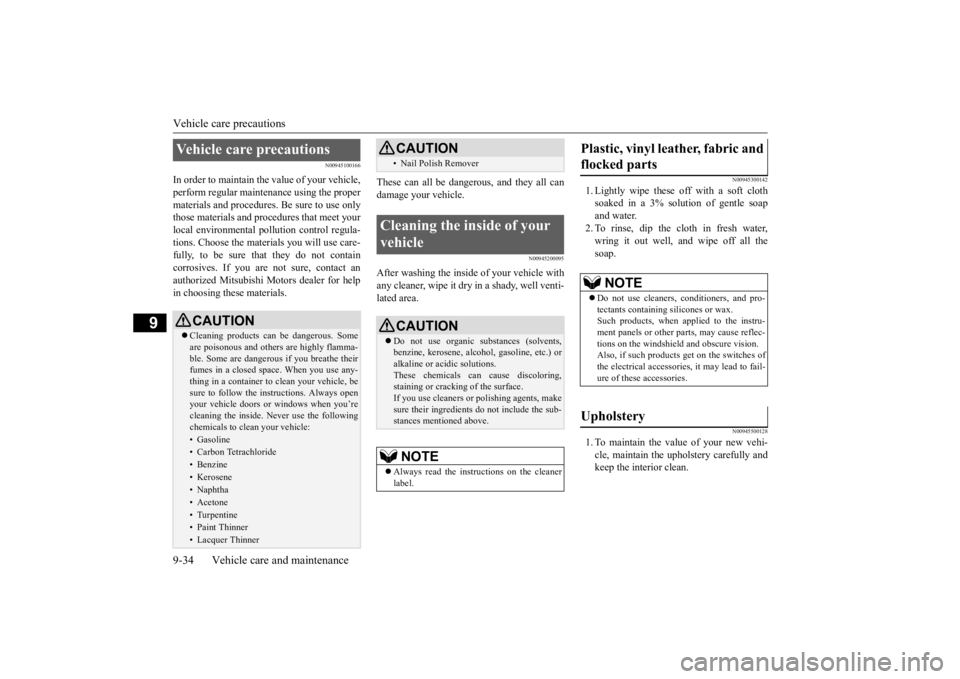
Vehicle care precautions 9-34 Vehicle care and maintenance
9
N00945100166
In order to maintain the value of your vehicle, perform regular maintenance using the proper materials and procedures
. Be sure to use only
those materials and proc
edures that meet your
local environmental pollution control regula- tions. Choose the material
s you will use care-
fully, to be sure that they do not contain corrosives. If you are not sure, contact an authorized Mitsubishi Mo
tors dealer for help
in choosing these materials.
These can all be danger
ous, and they all can
damage your vehicle.
N00945200095
After washing the inside
of your vehicle with
any cleaner, wipe it dry in a shady, well venti- lated area.
N00945300142
1. Lightly wipe these off with a soft clothsoaked in a 3% solution of gentle soapand water. 2. To rinse, dip the cloth in fresh water, wring it out well, a
nd wipe off all the
soap.
N00945500128
1. To maintain the value of your new vehi- cle, maintain the upholstery carefully and keep the interior clean.
Vehicle care precautions
CAUTION Cleaning products can be dangerous. Some are poisonous and othe
rs are highly flamma-
ble. Some are dangerous if you breathe their fumes in a closed space. When you use any- thing in a container to
clean your vehicle, be
sure to follow the instructions. Always open your vehicle doors or windows when you’re cleaning the inside. Never use the followingchemicals to clean your vehicle:• Gasoline• Carbon Tetrachloride• Benzine• Kerosene• Naphtha• Acetone• Turpentine• Paint Thinner• Lacquer Thinner
• Nail Polish Remover
Cleaning the inside of your vehicle
CAUTION Do not use organic s
ubstances (solvents,
benzine, kerosene, alc
ohol, gasoline, etc.) or
alkaline or acidic solutions.These chemicals can
cause discoloring,
staining or cracki
ng of the surface.
If you use cleaners or polishing agents, makesure their ingredients do not include the sub- stances mentioned above.NOTE
Always read the instru
ctions on the cleaner
label.CAUTION
Plastic, vinyl leather, fabric and flocked parts
NOTE
Do not use cleaners,
conditioners, and pro-
tectants containing
silicones or wax.
Such products, when applied to the instru- ment panels or other pa
rts, may cause reflec-
tions on the windshiel
d and obscure vision.
Also, if such products get on the switches of the electrical accessories, it may lead to fail- ure of these accessories.
Upholstery
BK0284300US.book 34 ページ 2019年5月23日 木曜日 午後12時22分
Page 232 of 253
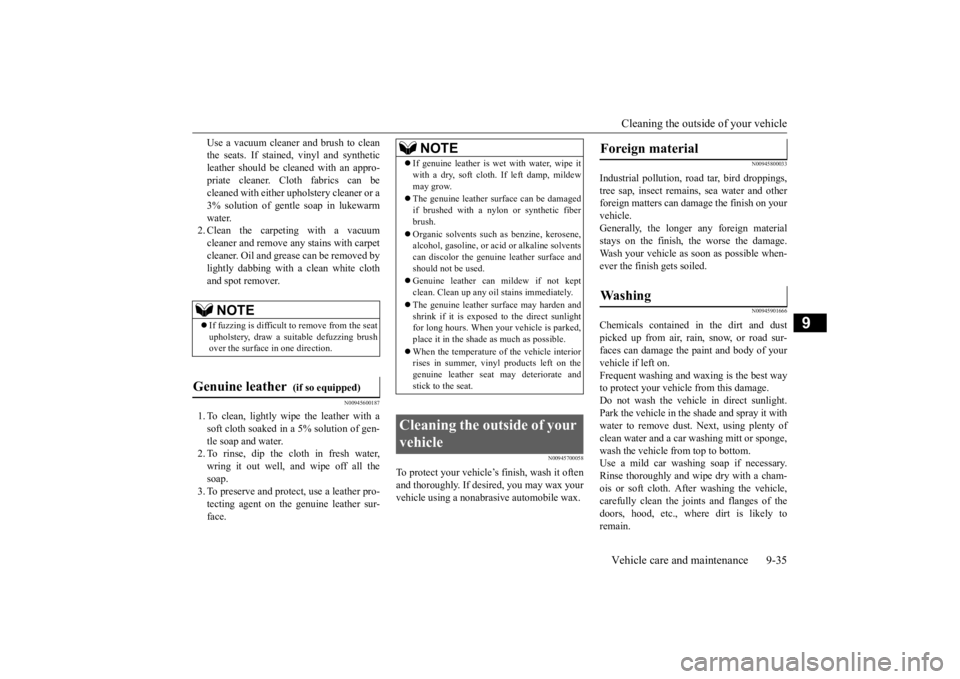
Cleaning the outside of your vehicle Vehicle care and maintenance 9-35
9
Use a vacuum cleaner
and brush to clean
the seats. If stained,
vinyl and synthetic
leather should be clea
ned with an appro-
priate cleaner. Cloth fabrics can be cleaned with either
upholstery cleaner or a
3% solution of gentle soap in lukewarm water. 2. Clean the carpeting with a vacuumcleaner and remove a
ny stains with carpet
cleaner. Oil and grea
se can be removed by
lightly dabbing with a clean white cloth and spot remover.
N00945600187
1. To clean, lightly wi
pe the leather with a
soft cloth soaked in a 5% solution of gen- tle soap and water. 2. To rinse, dip the cloth in fresh water,wring it out well, and wipe off all the soap. 3. To preserve and protect, use a leather pro-tecting agent on the genuine leather sur- face.
N00945700058
To protect your vehicle’s
finish, wash it often
and thoroughly. If desired, you may wax your vehicle using a nonabrasive automobile wax.
N00945800033
Industrial pollution, road tar, bird droppings,tree sap, insect remain
s, sea water and other
foreign matters
can damage the finish on your
vehicle. Generally, the longer
any foreign material
stays on the finish, the worse the damage.Wash your vehicle as soon as possible when- ever the finish gets soiled.
N00945901666
Chemicals contained in the dirt and dust picked up from air, rain, snow, or road sur-faces can damage the paint and body of your vehicle if left on. Frequent washing and wa
xing is the best way
to protect your vehicle from this damage. Do not wash the vehicl
e in direct sunlight.
Park the vehicle in the shade and spray it withwater to remove dust.
Next, using plenty of
clean water and a car
washing mitt or sponge,
wash the vehicle from top to bottom.Use a mild car washing soap if necessary. Rinse thoroughly and wipe
dry with a cham-
ois or soft cloth. Af
ter washing the vehicle,
carefully clean the join
ts and flanges of the
doors, hood, etc., wher
e dirt is likely to
remain.
NOTE
If fuzzing is difficult to remove from the seat upholstery, draw a suitable defuzzing brushover the surface in
one direction.
Genuine leather
(if so equipped)
NOTE
If genuine leather is we
t with water, wipe it
with a dry, soft cloth. If left damp, mildewmay grow. The genuine leather su
rface can be damaged
if brushed with a nylon or synthetic fiberbrush. Organic solvents such as benzine, kerosene, alcohol, gasoline, or acid
or alkaline solvents
can discolor the genuine
leather surface and
should not be used. Genuine leather can
mildew if not kept
clean. Clean up any oi
l stains immediately.
The genuine leather surface may harden and shrink if it is exposed to the direct sunlightfor long hours. When your vehicle is parked, place it in the shade as much as possible. When the temperature of the vehicle interior rises in summer, vinyl products left on the genuine leather seat
may deteriorate and
stick to the seat.
Cleaning the outside of your vehicle
Foreign material Wa s h i n g
BK0284300US.book 35 ページ 2019年5月23日 木曜日 午後12時22分
Page 233 of 253
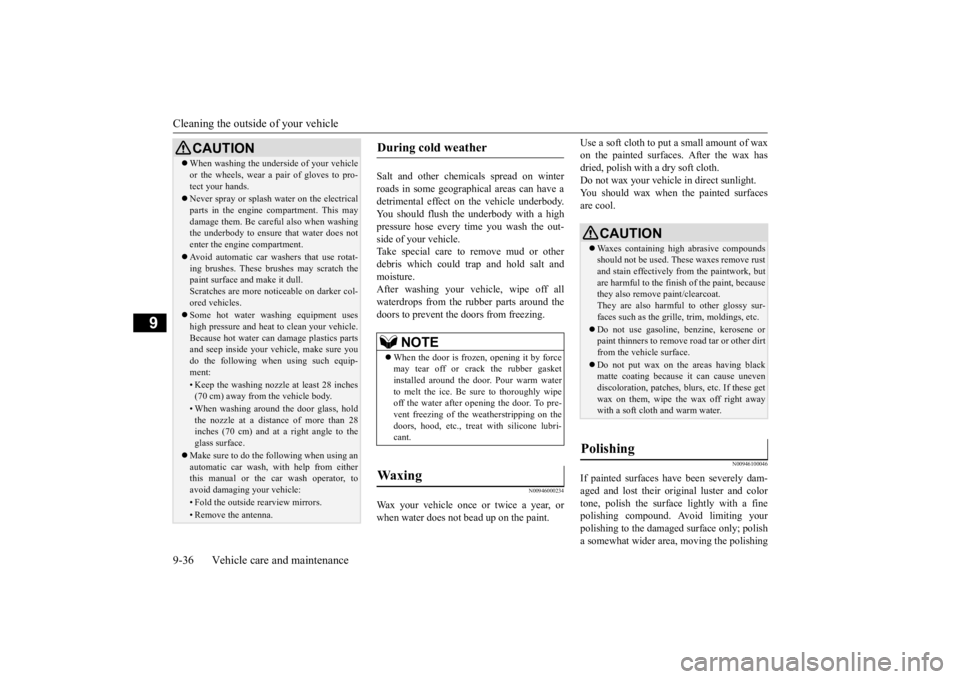
Cleaning the outside of your vehicle 9-36 Vehicle care and maintenance
9
Salt and other chemical
s spread on winter
roads in some geographical areas can have a detrimental effect on the vehicle underbody.You should flush the underbody with a high pressure hose every time you wash the out- side of your vehicle.Take special care to remove mud or other debris which could trap and hold salt and moisture. After washing your vehicle, wipe off all waterdrops from the rubber parts around thedoors to prevent the doors from freezing.
N00946000234
Wax your vehicle once or twice a year, orwhen water does not
bead up on the paint.
Use a soft cloth to put a small amount of wax on the painted surfaces.
After the wax has
dried, polish with
a dry soft cloth.
Do not wax your vehicle in direct sunlight. You should wax when the painted surfacesare cool.
N00946100046
If painted surfaces have
been severely dam-
aged and lost their original luster and color tone, polish the surface
lightly with a fine
polishing compound. Avoid limiting your polishing to the damage
d surface only; polish
a somewhat wider area, moving the polishing
CAUTION When washing the underside of your vehicle or the wheels, wear a pair of gloves to pro-tect your hands. Never spray or splash water on the electrical parts in the engine compartment. This maydamage them. Be careful also when washing the underbody to ensure that water does not enter the engine compartment. Avoid automatic car washers that use rotat- ing brushes. These br
ushes may scratch the
paint surface a
nd make it dull.
Scratches are more not
iceable on darker col-
ored vehicles. Some hot water wash
ing equipment uses
high pressure and heat
to clean your vehicle.
Because hot water can da
mage plastics parts
and seep inside your ve
hicle, make sure you
do the following when using such equip-ment:• Keep the washing nozzle at least 28 inches(70 cm) away from the vehicle body.• When washing around the door glass, holdthe nozzle at a distance of more than 28 inches (70 cm) and at a right angle to the glass surface.
Make sure to do the following when using an automatic car wash, with help from eitherthis manual or the car wash operator, to avoid damaging your vehicle:• Fold the outside
rearview mirrors.
• Remove the antenna.
During cold weather
NOTE
When the door is frozen, opening it by force may tear off or crack the rubber gasket installed around the door. Pour warm water to melt the ice. Be
sure to thoroughly wipe
off the water after opening the door. To pre- vent freezing of the
weatherstripping on the
doors, hood, etc., treat
with silicone lubri-
cant.
Waxing
CAUTION Waxes containing high abrasive compounds should not be used. Th
ese waxes remove rust
and stain effectively fr
om the paintwork, but
are harmful to the finish of the paint, because they also remove
paint/clearcoat.
They are also harmful to other glossy sur- faces such as the grille, trim, moldings, etc. Do not use gasoline, benzine, kerosene or paint thinners to remove
road tar or other dirt
from the vehicle surface. Do not put wax on the areas having black matte coating because
it can cause uneven
discoloration, patches, bl
urs, etc. If these get
wax on them, wipe the wax off right away with a soft clot
h and warm water.
Polishing
BK0284300US.book 36 ページ 2019年5月23日 木曜日 午後12時22分
Page 234 of 253
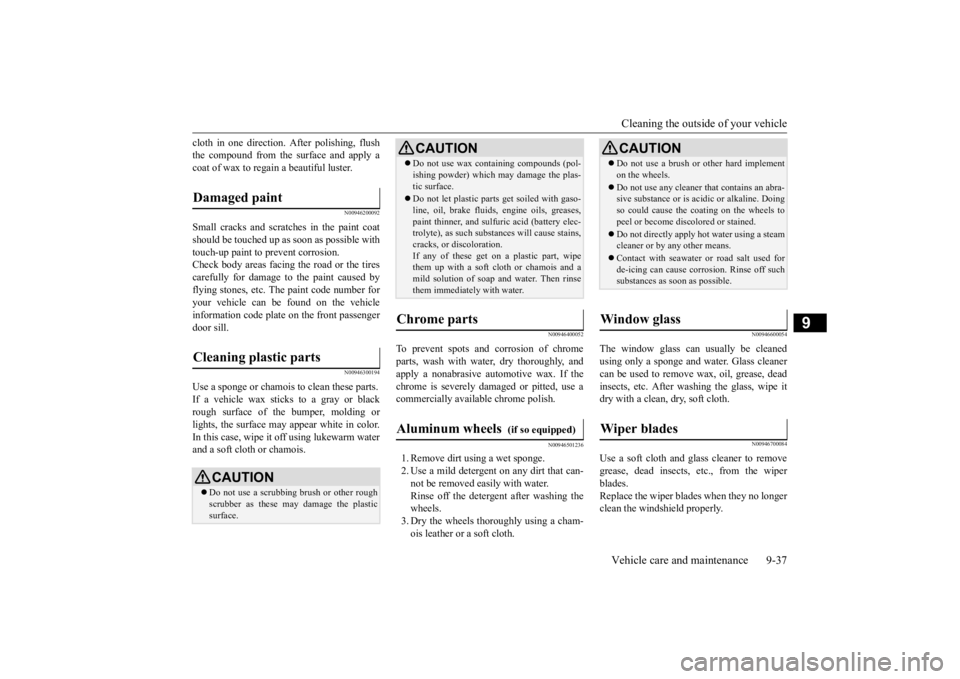
Cleaning the outside of your vehicle Vehicle care and maintenance 9-37
9
cloth in one direction.
After polishing, flush
the compound from the surface and apply acoat of wax to regain a beautiful luster.
N00946200092
Small cracks and scratches in the paint coatshould be touched up as
soon as possible with
touch-up paint to prevent corrosion. Check body areas facing the road or the tires carefully for damage to the paint caused by flying stones, etc. The
paint code number for
your vehicle can be found on the vehicle information code plat
e on the front passenger
door sill.
N00946300194
Use a sponge or chamois to clean these parts.If a vehicle wax sticks to a gray or blackrough surface of the bumper, molding or lights, the surface may appear white in color. In this case, wipe it
off using lukewarm water
and a soft cloth or chamois.
N00946400052
To prevent spots and corrosion of chromeparts, wash with water, dry thoroughly, andapply a nonabrasive automotive wax. If the chrome is severely da
maged or pitted, use a
commercially available chrome polish.
N00946501236
1. Remove dirt using a wet sponge.2. Use a mild detergent on any dirt that can-not be removed ea
sily with water.
Rinse off the detergent after washing the wheels.3. Dry the wheels thoroughly using a cham- ois leather or a soft cloth.
N00946600054
The window glass can
usually be cleaned
using only a sponge and
water. Glass cleaner
can be used to remove
wax, oil, grease, dead
insects, etc. After washing the glass, wipe it dry with a clean, dry, soft cloth.
N00946700084
Use a soft cloth and gl
ass cleaner to remove
grease, dead insects, etc., from the wiperblades. Replace the wiper blades when they no longer clean the windshield properly.
Damaged paint Cleaning plastic parts
CAUTION Do not use a scrubbing brush or other rough scrubber as these may
damage the plastic
surface.
Do not use wax containing compounds (pol- ishing powder) which ma
y damage the plas-
tic surface. Do not let plastic parts get soiled with gaso- line, oil, brake fluids
, engine oils, greases,
paint thinner, and sulfur
ic acid (battery elec-
trolyte), as such substa
nces will cause stains,
cracks, or discoloration.If any of these get on a plastic part, wipe them up with a soft cloth or chamois and a mild solution of soap and water. Then rinsethem immediately with water.
Chrome parts Aluminum wheels
(if so equipped)
CAUTION
CAUTION Do not use a brush or
other hard implement
on the wheels. Do not use any cleaner th
at contains an abra-
sive substance or is ac
idic or alkaline. Doing
so could cause the coating on the wheels topeel or become disc
olored or stained.
Do not directly apply
hot water using a steam
cleaner or by any other means. Contact with seawater or road salt used for de-icing can cause corr
osion. Rinse off such
substances as soon as possible.
Window glass Wiper blades
BK0284300US.book 37 ページ 2019年5月23日 木曜日 午後12時22分
Page 235 of 253

Cleaning the outside of your vehicle 9-38 Vehicle care and maintenance
9
N00947000071
Never spray or splash
water on the electrical
accessories in the engine compartment. This puts the engine at risk of being damaged.Do not bring the circum
ferential parts, the
plastic parts and so on
into contact with sulfu-
ric acid (battery electrolyte) which maycrack, stain or discolor them. If they are in contact, wipe off with soft cloth, chamois or the like and an aqueous solution of neutral detergent th
en immediately rinse
the affected parts with plenty of water.Engine compartment BK0284300US.book 38 ページ 2019年5月23日 木曜日 午後12時22分
Page 236 of 253
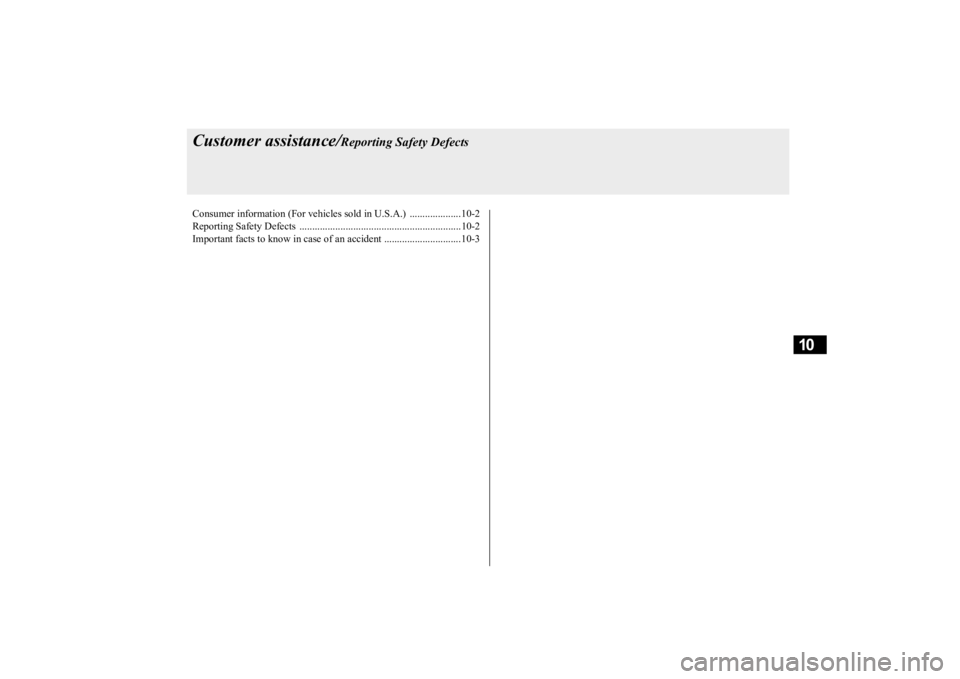
10
Customer assistance/
Reporting Safety Defects
Consumer information (For vehicles sold in U.S.A.) ....................10-2 Reporting Safety Defects ...............................................................10-2 Important facts to know in
case of an accident ....
..............
............10-3
BK0284300US.book 1 ページ 2019年5月23日 木曜日 午後12時22分
Page 237 of 253
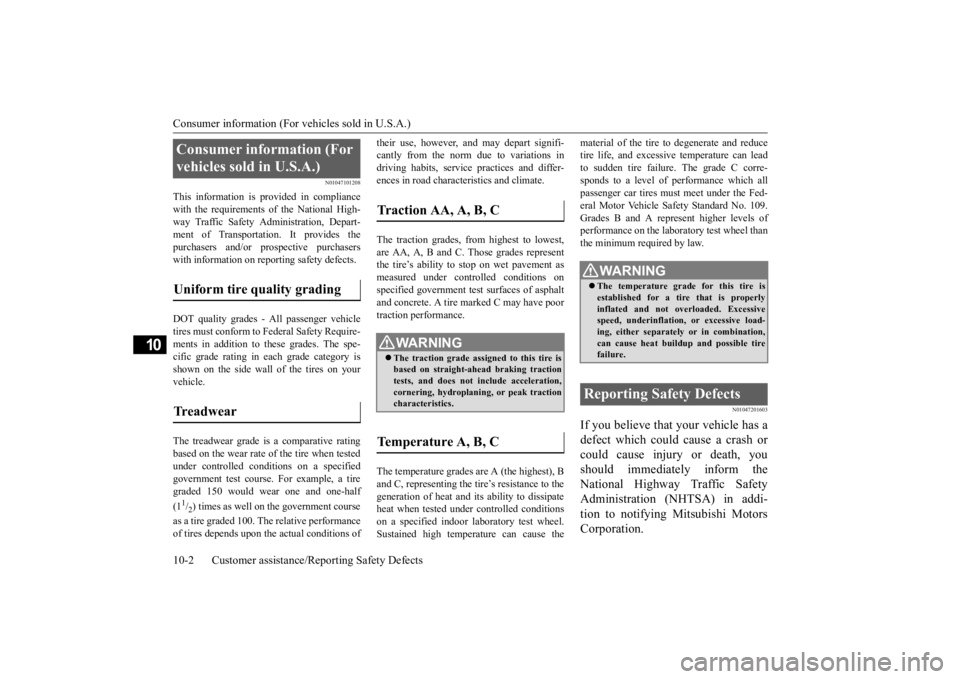
Consumer information (For vehicles sold in U.S.A.) 10-2 Customer assistance/Re
porting Safety Defects
10
N01047101208
This information is provided in compliance with the requirements of the National High- way Traffic Safety Ad
ministration, Depart-
ment of Transportation. It provides the purchasers and/or prospective purchasers with information on repor
ting safety defects.
DOT quality grades - Al
l passenger vehicle
tires must conform to
Federal Safety Require-
ments in addition to these grades. The spe- cific grade rating in each grade category isshown on the side wall of the tires on your vehicle. The treadwear grade is a comparative rating based on the wear rate of
the tire when tested
under controlled conditions on a specifiedgovernment test course
. For example, a tire
graded 150 would wear one and one-half (11/2) times as well on the government course
as a tire graded 100.
The relative performance
of tires depends upon the actual conditions of
their use, however, and may depart signifi- cantly from the norm due to variations indriving habits, service practices and differ- ences in road characteristics and climate. The traction grades, from highest to lowest, are AA, A, B and C. Those grades represent the tire’s ability to
stop on wet pavement as
measured under controlled conditions on specified government te
st surfaces of asphalt
and concrete. A tire marked C may have poor traction performance. The temperature grades are A (the highest), B and C, representing the ti
re’s resistance to the
generation of heat and it
s ability to dissipate
heat when tested un
der controlled conditions
on a specified indoor
laboratory test wheel.
Sustained high temperature can cause the
material of the tire to
degenerate and reduce
tire life, and excessive temperature can leadto sudden tire failure. The grade C corre- sponds to a level of performance which all passenger car tires must meet under the Fed-eral Motor Vehicle Safety Standard No. 109. Grades B and A represent higher levels of performance on the labora
tory test wheel than
the minimum required by law.
N01047201603
If you believe that your vehicle has a defect which could cause a crash or could cause injury or death, you should immediately inform theNational Highway Traffic Safety Administration (NHTSA) in addi- tion to notifying Mitsubishi MotorsCorporation.
Consumer information (For vehicles sold in U.S.A.) Uniform tire quality grading Treadwear
Traction AA, A, B, C
WA R N I N G The traction grade assi
gned to this tire is
based on straight-ahead braking tractiontests, and does not include acceleration, cornering, hydroplani
ng, or peak traction
characteristics.
Temperature A, B, C
WA R N I N G The temperature grade for this tire is established for a tire that is properlyinflated and not overloaded. Excessive speed, underinflation
, or excessive load-
ing, either separately
or in combination,
can cause heat buildup and possible tire failure.
Reporting Safety Defects
BK0284300US.book 2 ページ 2019年5月23日 木曜日 午後12時22分
Page 238 of 253
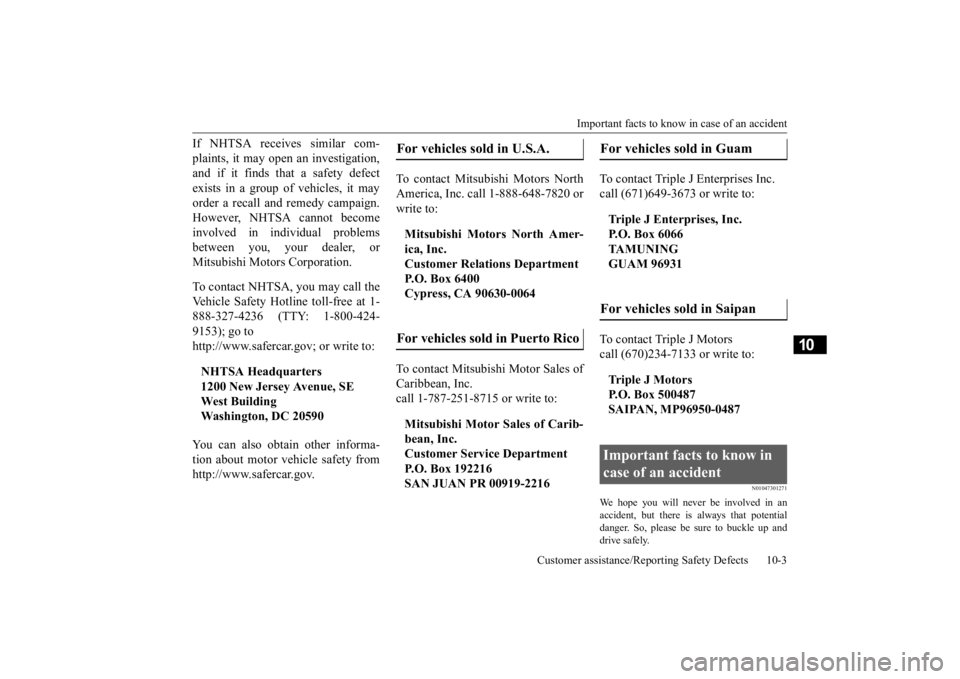
Important facts to know
in case of an accident
Customer assistance/Reporting Safety Defects 10-3
10
If NHTSA receives similar com- plaints, it may open an investigation, and if it finds that a safety defect exists in a group of vehicles, it mayorder a recall and remedy campaign. However, NHTSA cannot become involved in individual problemsbetween you, your dealer, or Mitsubishi Motors Corporation. To contact NHTSA, you may call the Vehicle Safety Hotline toll-free at 1- 888-327-4236 (TTY: 1-800-424-9153); go to http://www.safercar.gov; or write to: You can also obtain other informa- tion about motor vehicle safety from http://www.safercar.gov.
To contact Mitsubishi Motors North America, Inc. call 1-888-648-7820 or write to: To contact Mitsubishi Motor Sales of Caribbean, Inc. call 1-787-251-8715 or write to:
To contact Triple J Enterprises Inc. call (671)649-3673 or write to: To contact Triple J Motors call (670)234-7133 or write to:
N01047301271
We hope you will never be involved in an accident, but there is
always that potential
danger. So, please be sure to buckle up anddrive safely.
NHTSA Headquarters 1200 New Jersey Avenue, SEWest Building Washington, DC 20590
For vehicles sold in U.S.A. Mitsubishi Motors North Amer- ica, Inc. Customer Relations Department P.O. Box 6400Cypress, CA 90630-0064For vehicles sold in Puerto Rico Mitsubishi Motor Sales of Carib-bean, Inc. Customer Service Department P.O. Box 192216SAN JUAN PR 00919-2216
For vehicles sold in Guam Triple J Enterprises, Inc.P.O. Box 6066TAMUNING GUAM 96931For vehicles sold in Saipan Tr i p l e J M o t o r s P.O. Box 500487 SAIPAN, MP96950-0487Important facts to know in case of an accident
BK0284300US.book 3 ページ 2019年5月23日 木曜日 午後12時22分
Page 239 of 253

Important facts to know
in case of an accident
10-4 Customer assistance/Re
porting Safety Defects
10
Remain calm. Check for injuries. Report all injuries to the police, and, if necessary, call for an ambulance. Record all the details of the accident. This will provide you with accurate records of the accident for discussions with yourinsurance company and other persons who may be acting on your behalf. Understand your repa
ir estimate before
approving repairs. Choosing the repair shop and the brands of parts that they use on your vehicle is your decision. Ask for genuine Mits
ubishi Motors parts.
Many times, to save
money, your insur-
ance company will recommend imitationparts that do not meet the original specifi- cations of fit, finish, corrosion resistance or workmanship.
The strength and integrity built into your vehicle is the result of a specific designreferred to as “Ener
gy Management”. Indi-
vidual body parts are designed to act as one unit in the event of an accident. Shock wavesare absorbed by protective panels or are chan- neled around the pass
enger compartment.
This important featur
e is possible because
high tensile steel is used
in panels and struc-
tural parts, something
that cannot be guaran-
teed by the manufacturers of imitation parts. All Genuine Mitsubishi Motors body panels and support brackets
are designed and con-
structed as important protection features in the event of an accident. By replacing body parts with non-Genuine Mitsubishi Motorsparts, your vehicle may no longer meet origi- nal equipment specifications. As a consumer reque
sting repair on your
vehicle, you have cons
umer rights. Across the
country, State Insuranc
e Commissioners have
begun considering rules on the use of non- OEM parts. This could
mean that repair shops
will have to disclose to the consumer when they intend to use non-O
EM parts. Since reg-
ulations are not cons
istent on this point,
remember you have a choice. So, if you want genuine Mitsubishi Motors parts, you mayhave to specifically
request them. Make cer-
tain your insurance company understands imitations are not to be used in the repair ofyour vehicle. You deserve the best genuine Mitsubishi Motors parts. Genuine Mitsubishi Motors parts are built with the high quality a
nd durability standards
you expect. Genuine Mitsubishi Motors replacements parts are your guarantee thatyour vehicle will have
all the technological
advantages and maintain
the style and protec-
tion of a brand new Mitsubishi Motors.Remember to ask for genuine Mitsubishi Motors parts.
In the event of an accident Key information to discuss with your insurance company
Mitsubishi Motors built-in pro-tection Consumer rights (For vehicles sold in U.S.A.)
Genuine Mitsubishi Motors parts
BK0284300US.book 4 ページ 2019年5月23日 木曜日 午後12時22分
Page 240 of 253
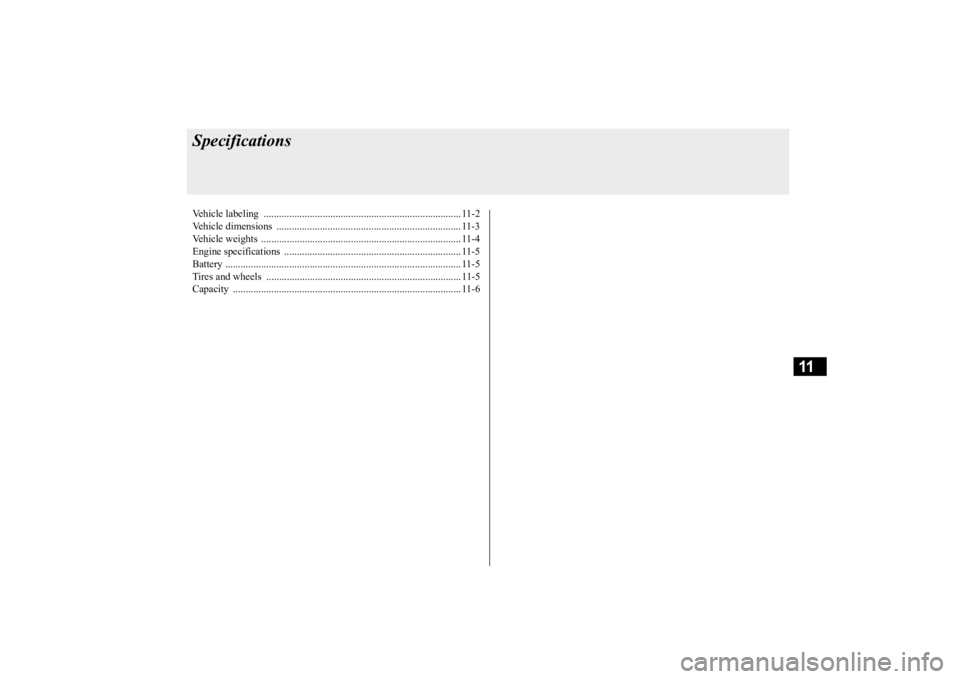
11
SpecificationsVehicle labeling ............................................................................. 11-2 Vehicle dimensions ........................................................................ 11-3 Vehicle weights .............................................................................. 11-4Engine specifications ..................................................................... 11-5 Battery ............................................................................................ 11-5 Tires and wheels ............................................................................ 11-5Capacity ......................................................................................... 11-6
BK0284300US.book 1 ページ 2019年5月23日 木曜日 午後12時22分